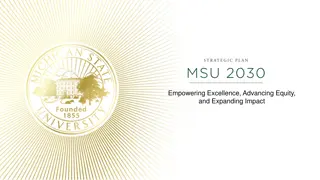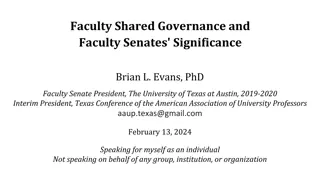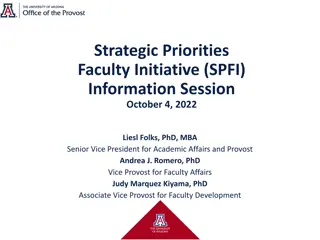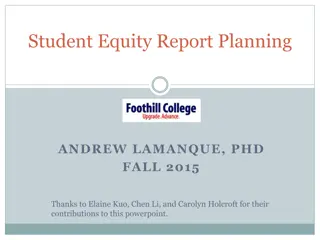
Equity in Faculty Hiring and Campus Organizational Culture
Discover the importance of equity in faculty hiring to meet the needs of students of color, the significance of campus organizational culture in supporting faculty diversity, and characteristics of an affirming culture for faculty of color. Learn how hiring practices and culture impact student success.
Download Presentation

Please find below an Image/Link to download the presentation.
The content on the website is provided AS IS for your information and personal use only. It may not be sold, licensed, or shared on other websites without obtaining consent from the author. If you encounter any issues during the download, it is possible that the publisher has removed the file from their server.
You are allowed to download the files provided on this website for personal or commercial use, subject to the condition that they are used lawfully. All files are the property of their respective owners.
The content on the website is provided AS IS for your information and personal use only. It may not be sold, licensed, or shared on other websites without obtaining consent from the author.
E N D
Presentation Transcript
Equity in Faculty Hiring Department Chairs Meeting December 1, 2017
Why is there a need for equity in faculty hiring? Faculty should represent, understand, and teach to the needs of their student body. Academia has traditionally centered whiteness this leans towards white or Eurocentric ideals. This inherently leaves out the needs and interests of students of color. Faculty, next to the students, represent the heart of the college. A. We determine curriculum B. We set the tone for the college C. We play a large role in the development and implementation of policies that affect students. D. We determine the playing field for the students whether or not they know how to play the game is up to us. If we traditionally teach in a manner that is not effective and inclusive to our students of color, then we have inherently created a racist environment that creates a system of inequality which leads to an environment that impedes student success.
Who are the SMC students? 40% Latino 9% African American THIS IS NEARLY 50% OF OUR STUDENT POPULATION These ARE our students. How do we help to increase student success of OUR students? Ensuring that faculty that are hired possess the skills that we need to reach OUR students. We need to create a playing field that meets the needs, whatever they may be.
What is our campus organizational culture? Is it affirming or non-affirming? What is our organizational culture? What are our espoused values, artifacts, underlying assumptions, areas of importance, etc? This determines who we hire, how we hire and how our faculty are acculturated to the college. Our organizational culture determines who is in the in group and who is not. The culture determine who is part of the campus power structure and who is not. The values of the power structure at SMC have not reflected the needs of students of color. Change in power is slow to occur but not impossible. It is important that our campus organizational culture attracts and hires faculty of color as part of the move towards fostering equitable outcomes for students of color. Faculty of color reflect the experiences of students of color but the responsibility of equitable outcomes is the responsibility of all of us.
Characteristics of an affirming organizational culture for faculty of color Campus and departments organize social events. Department chairs (and administrators) frequently validate the experiences of faculty of color. Faculty of color feel a sense of belonging. Faculty of color feel that their experiences are validated. Faculty of color s expertise is considered in decision-making. There s a campus-wide awareness that faculty of color are not soley responsible for sharing their possibly traumatic experiences in academia to teach others about being race conscious and equitable.
Characteristics of non-affirming organizational culture Faculty of color feel a sense of isolation. Campus structure is one of stratification or decentralization (silo effect) Experiences of faculty of color are dismissed. Racial microaggressions come from leadership and colleagues. Leadership and/or colleagues have deficit-minded views of students ( it s all their fault that they don t do well in my subject matter. They are not prepared! ) A campus-wide assumption that faculty of color will be the voice of diversity on committees (I am asked to read the diversity question ). An expectation that faculty of color have to do the intellectual and emotional labor to teach white faculty about being race conscious. Campus defers to white men or white faculty as authorities (Example that was witnessed)
Redesigning, rethinking how we evaluate potential hires Redefining the concepts of fit and merit and how this can be inherently racist in the selection of faculty. Who benefits from the hiring? Who is best served by the faculty member being selected? Do African American and Latino students get best served by the hire or is the hire supposed to be a one-size-fits all kind of person? Re-center race-consciousness this is the part that folks will find HUGELY difficult and will also require a change in our practices. Paying attention to make sure that the hiring practices don t unduly eliminate people of color and don t give advantages to white candidates.






















